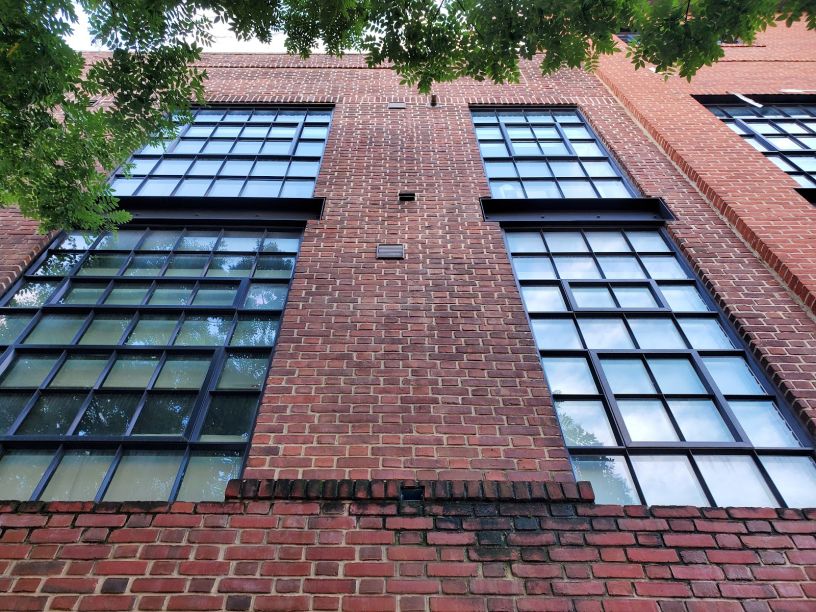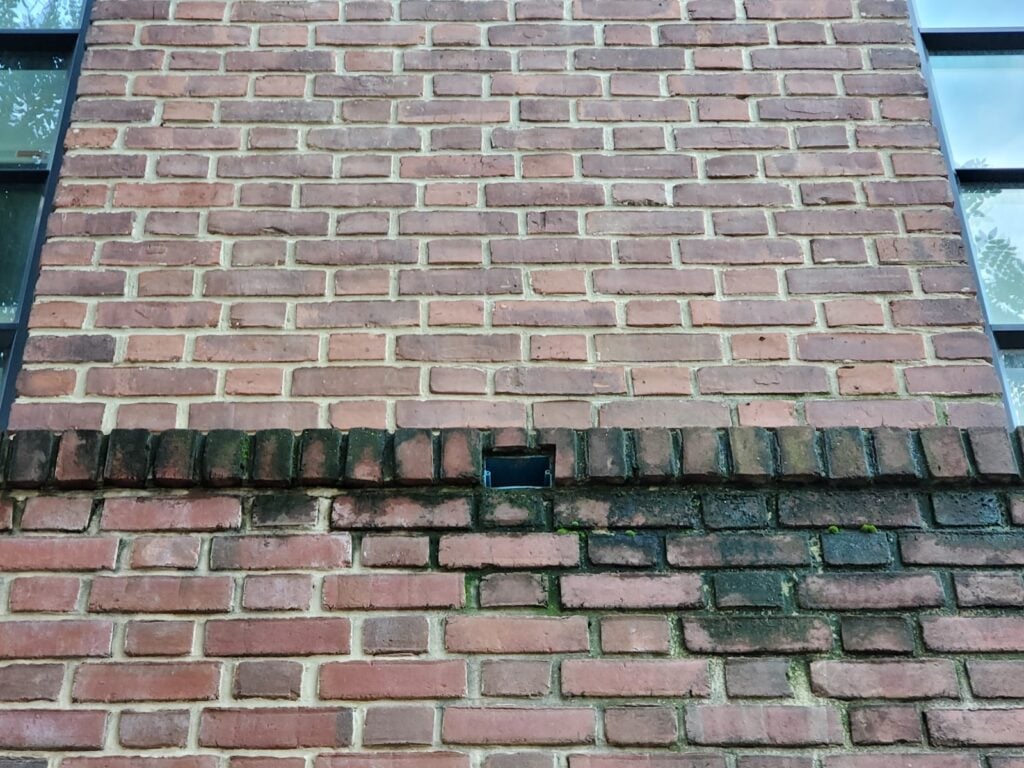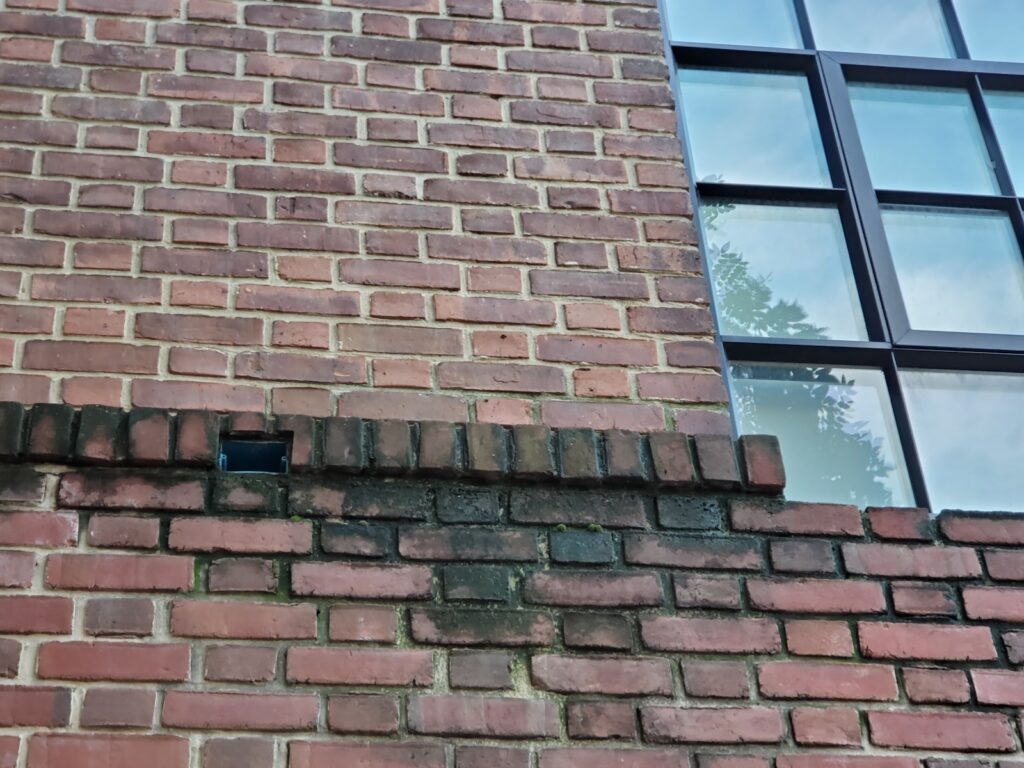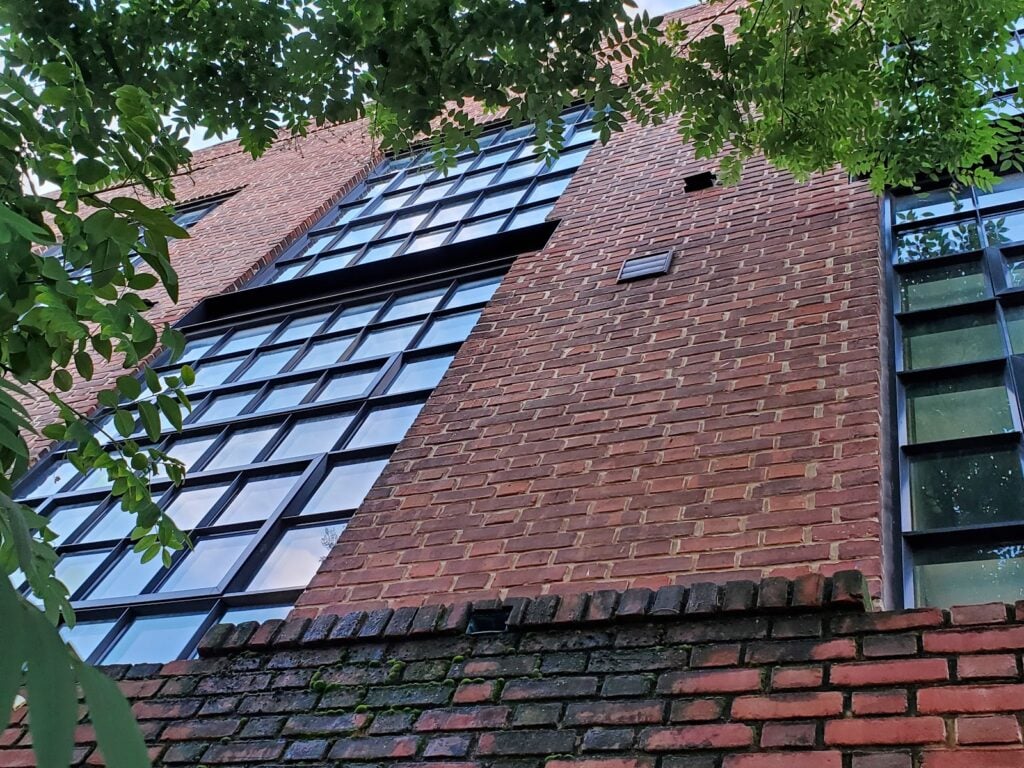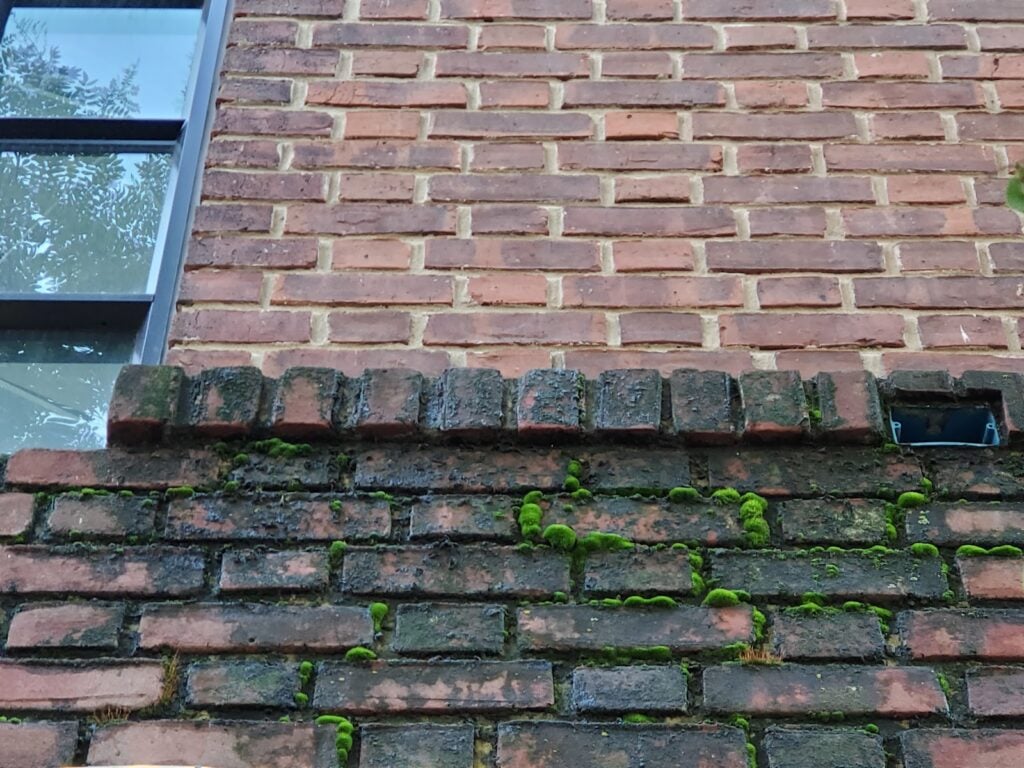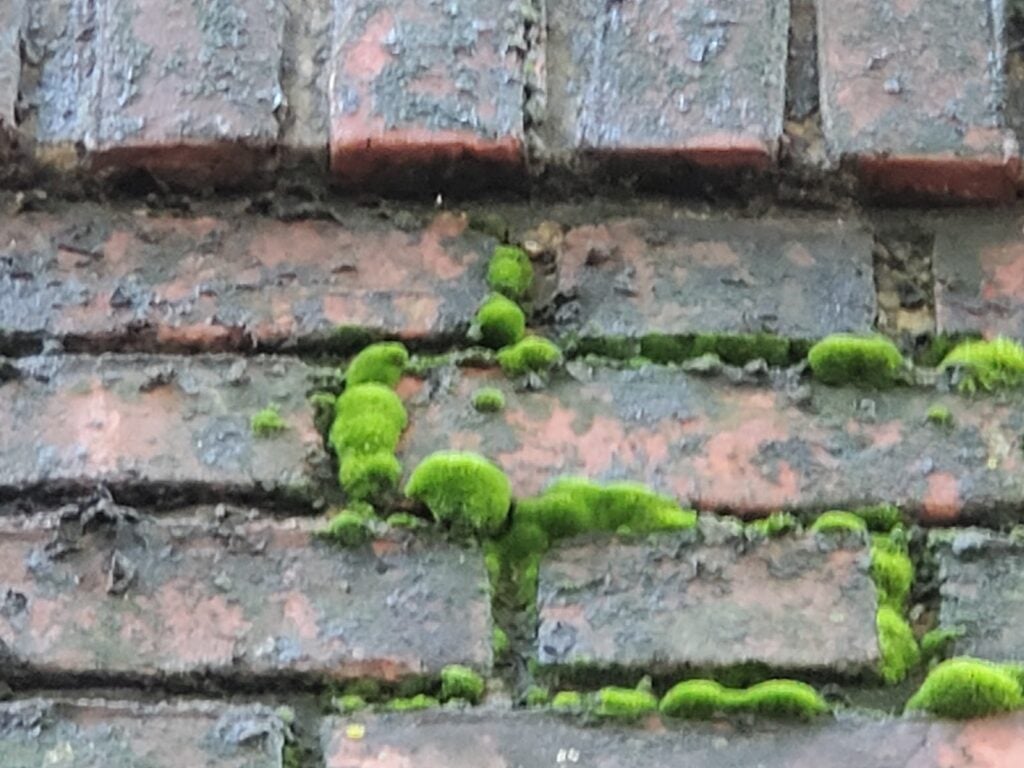What Is Functional Engineering And How Do You Protect Masonry Facade?
This week, we present the third part of a three part series, a continuation on the discussion about the Vitruvian Wave and projecting elements of masonry facades. The outline of the articles in this series follows below:
- Vitruvian Waves and Architectural Friezes – Part I
-
- The history of architectural friezes
-
- Use of architectural friezes in the New World
-
- The Vitruvian Wave
-
- Noteworthy American relief
- Vitruvian Waves and Architectural Friezes – Part II
-
- Distinctions between carved masonry and cast materials
-
- A kerf at a sill
-
- A rectilinear alternative Vitruvian wave
- Functional engineering and protection of a masonry facade
-
- Protection, projections, and capping
-
- Biocolonization
-
- Mortar deterioration
- Tuckpointing and repointing
In last week’s article we took a look at an existing historic building with a light gray sandstone facade. The masonry frieze at the top of the ground level in the iron spot brick facade showed signs of excessive water entry, deterioration, and discoloration.
A link to that blog follows for reference:
Vitruvian Waves and Architectural Friezes – PART II
Today we’re looking at a very similar problem or defect causing deterioration through water entry and accelerated decomposition of brick masonry at a building facade. The particular context related to the frieze that we saw in the last article, was that that frieze created a ledge or projection slightly away from the facade of the building.
Protection, projections, and capping
That projecting ledge essentially protects the lower portion of the facade below the frieze area, essentially creating a miniature awning or roof above the lower portion of the facade. During heavy precipitation with high winds, this type of projection would be largely ineffective to protect the lower area of the wall, however, during the majority of precipitation events with low wind, this type of facade projection is very effective to keep the lower area of the wall relatively dry.
Masonry and brick facades of historic construction are generally very resistant to moderate exposure to the elements including precipitation for up to hundreds of years, but repeated exposure to moisture will break down the elements of brick and especially lime mortar. Further below we discuss the importance of tuckpointing, repointing, routine maintenance, and upkeep.
We also looked at the example of a kerf or chamfer at the outer edge of tge underside of a projecting facade element, working similarly to a typical metal drip edge in contemporary or modern construction which allows water to roll off of an edge of a projection without rolling back to the vertical facade. Unlike non-water based liquids, water has a cohesive bond innate to the molecular structure, so water has a tendency to roll back and even stick to things a little bit and without a drip edge or chamfer cut into the underside of the projecting masonry, as was shown in our example, water can run from a standing or projecting ledge, back to a facade. In this case though this type of detail allows the water to drip away from the building without running all the way back, in the absence of significant winds.
Similar to that iron spot brick masonry building in the previous blog, the building in the picture below was built with a structural brick facade. The lower portion of the building projects farther away than the upper portion of the building. The upper portion of the building was added as part of a retrofit after the original construction. The lower portion of the building below the projecting area of the wall was original. The designer did a good job to match some of the historic masonry details from the original construction. For example, they have used a structural red brick in a Flemish bond for the construction of the upper portions of the wall, to continue the pattern of the original wall.
Bioconalization
The older or more original lower portion of the wall was tuckpointed or repointed with a similar color mortar, as used in the newer portion of the wall above. In both the picture above and the picture below, you can see a dark area below the projecting ledge of brick. The mortar joints of that area and even the face of the brick units themselves are stained dark with dirt and bioconalization. Bioconalization is the phenomenon of moisture Infiltrating into masonry services sufficiently to break down the exterior surface of the mortar into base components such as sand and silica, allowing plant growth. As the mortar breaks down, plants can begin to take root on the face of that masonry, especially in conditions with repeat and continuous high moisture. The surface of the masonry essentially becomes a perfect breeding ground for certain types of moss and plants. After moss begins to grow on the surface of a brick masonry facade, as shown in these photos, the plants that grow on the face of the masonry will evolve in succession, each breaking down the masonry and brick mortar farther so that higher forms of plant growth can take root deeper into the brick surface.
Mortar Deterioration
This sort of deterioration happens at an accelerating rate, as one area of masonry begins to deteriorate, that deterioration continues but at an increasing rate, faster and faster. Usually, in a mathematical presentation, this sort of increasing or accelerating deterioration would be described as non-linear, as the curve of deterioration continues but at a greater degree at each step in progression. From a building life-cycle management perspective, it is extremely beneficial and financially rewarding to invest in upkeep and preventative maintenance in historic brick facade buildings.
The brick ledge shown in these photos is a rowlock course of masonry at a relatively low-slope. Sills, as used in windows or other projecting horizontal surfaces should be built with a cant, bevel, or slope from the exterior facade area of construction towards the outermost edge of the facade. An intended slope at a projecting horizontal area allows water to passively drain away from the building. This slope is a subtle yet important detail of design, at the majority of sills and horizontal areas. These areas bear the majority of residual repeat exposure to precipitation and hydration.
A rowlock course of masonry, as used in this particular example, is technically an acceptable method of creating a sill, but generally for masonry copings or cappings at horizontal areas such as ledges, sills, retaining walls, and other exposed horizontal surfaces, it is sometimes (depending on configuration) a better practice to use longer units of masonry or stones that are set in a stretcher position. The difference may appear subtle in the overall design of the facade or layout of the construction, but effectively the ratio of joints to the respective masonry surface is decreased significantly by flipping the layout to a stretcher configuration. Sometimes though a rowlock course is structurally necessary because the brick spans both courses in a double whythe construction, structurally tying the top of the wall together between individual wythes of brick. That happens to not be the case though in this particular example, both because of the upper portion of the wall only being recessed 4″ shy of the lower facade and since it is a Flemish bond the wall is already built with high interconnection between wythes of brick.
There are six main facings for brick positioning. A brick has 6 sides, but each of those sides have a matching opposite face. In total, each brick has 3 different side types that can be used as a facing, but each of those sides can be set in a vertical or horizontal running position. These six main facings follow: shiner, soldier, sailor, stretcher, rowlock, header. We have an encyclopedia of historic masonry restoration terminology on our website where we have listed more detailed descriptions of each of these facing types there on outer site, at the following link:
Facings, of ashlar and brick masonry
Brick, or ashlar masonry facings, refer to different orientations and placements of bricks in a brick wall or facade. Here’s an explanation of each brick facing:
- Soldier: A soldier course consists of bricks placed vertically with their long faces visible. The bricks are positioned in a row, standing upright like soldiers in formation. This creates a strong, vertical emphasis in the wall.
- Sailor: Similar to a soldier course, a sailor course also involves bricks placed vertically. However, in a sailor course, the bricks are positioned with their short faces visible. This creates a horizontal emphasis in the wall.
- Shiner: In a shiner course, the long face of the brick is visible, creating a flat surface. The narrow end, or header, is hidden within the wall. This results in a wall with a smooth, uniform appearance
- Stretcher: A stretcher course is the most common brick orientation. The bricks are laid flat with their long faces visible and aligned horizontally. The length of the brick extends across the width of the wall, creating a traditional, linear appearance.
- Header: A header course consists of bricks placed with their narrow ends visible. This means that only the short face of each brick is visible. Header courses are typically used at the ends of walls or as a transition between different brick orientations.
- Rowlock: In a rowlock course, the bricks are positioned on their narrow sides, with the long face of each brick visible. This creates a narrow, linear projection from the wall, as if the bricks are standing on their edges. Rowlock courses are often used to create decorative detailing or to form a projecting element in the wall.
These brick facings allow builders and architects to create different visual effects, patterns, and structural characteristics in brick walls, adding variety and interest to architectural designs.
If you look closely, in the photo below, you can see that each area of exposed masonry, at each recessed mortar joint in the brickwork below the projecting ledge has dark areas of dirt and bioconization from exposure to excess moisture that has permeated through the projecting sill. This damage has taken place over years, not just one season of exposure to the elements, yet the damage is insidious because it has caused the breakdown of the mortar joints around each area of brick.
The next pictures below show a different but adjacent area of the same wall. The big causal factor for the increased amount of biocolonization between the section of the wall shown in the photo above versus the one below is that the one below is shaded by a tree. There is a tree growing in the city sidewalk, right in front of the area with significantly higher bioconalization. Essentially, this means that since this portion of the wall is shaded and has less exposure to sunlight, it dries out much slower, therein has longer periods of hydration at or following each precipitation event and therefore experiences slightly more water damage at each successive rainfall. This picture, and the resultant comparison with photos above show a drastic visual contrast. Masonry preservation is costly, but can save so much!
Tuckpointing and repointing
Tuckpointing and repointing are crucial processes for preserving the integrity of a masonry facade, enhancing building longevity, and reducing overall repair costs. We take a closer look at the process below and describe how it contributes to these benefits. Tuckpointing is a technique used to repair deteriorating mortar joints in a masonry wall. Over time, as shown the photos here at the projecting sill, the mortar between bricks can degrade due to exposure to precipitation and related moisture. Tuckpointing involves removing a portion of the outermost deteriorated mortar and replacing it with new (yet historically compatible) mortar, which restores the structural stability and moisture mitigation of the wall or facade.
It’s extremely important that the mortar used in pointing is historically compatible. This, more than anything else, is the number one difference between good and bad pointing work. There are tons of differing characteristics related to quality and professionalism, but if you hire a cheap contractor to point your facade, and they don’t have knowledge, training and experience to get the mortar right, the damage caused by using the wrong mortar can be disastrously expensive.
By properly restoring deteriorating mortar joints through tuckpointing, the integrity of the masonry facade is preserved. Restored and tuckpointed mortar joints prevent moisture infiltration, reducing the risk of water damage to the underlying substrate and internal building structure. Moisture intrusion can cause various problems such as efflorescence (salt deposits on the surface), mold growth, freeze-thaw damage, and biocolonization. The deleterious effects described can all ultimately compromise the stability of the masonry wall. Tuckpointing ensures that the facade remains strong and resistant to external elements.
By preventing moisture infiltration and subsequent damage, tuckpointing extends the lifespan of the masonry facade and the entire building. It helps maintain the structural integrity of the walls, preventing cracks, displacement, or even eventual collapse. Timing matters, addressing mortar deterioration early on, tuckpointing minimizes the need for more extensive repairs or complete wall replacement as we have shown on our website in the moat extreme circumstances. Proper tuckpointing seems expensive, but it can last for decades and can lead to significant cost savings in the long run. By addressing deteriorating mortar joints at an early stage, you can prevent further damage to the masonry facade and the underlying structure. This proactive approach avoids the need for extensive repairs, reconstruction, or even replacement, which can be considerably more expensive.
Regular tuckpointing maintenance is a cost-effective requirement to preserve the facade, enhance building longevity, and avoid costly repairs or renovations down the line. In summary, tuckpointing and repointing play vital roles in preserving a masonry facade and increasing building longevity while reducing overall repair costs. These maintenance practices address deteriorating mortar joints, prevent moisture infiltration, maintain structural integrity, and help avoid more extensive and expensive repairs. By investing in tuckpointing, building stewards and owners can ensure the longevity and durability of their masonry facades while minimizing the need for costly repairs or reconstruction in the future.
Historic masonry upkeep and preservation
To properly maintain, repair, and care for these historic buildings, a knowledge, interest and understanding of historic building principles is required. Here in Washington DC, historic masonry buildings are extremely expensive and the amount of financial loss caused by improper repointing and low quality construction is staggering. However, in addition to the direct financial value of the property, there is also a cultural loss when historic buildings are damaged. By comparison, consider neighboring poor cities, when historic buildings are damaged, it’s not just the loss of value to the property owner, there’s also a loss to all inhabitants and visitors of a city, present and future, who care about architecture, history, and culture.
We encourage all of our clients, and all readers of this article and to our blog in general, to prioritize the historic built environment of Washington DC and neighborhoods such as Capitol Hill, Dupont Circle, and Georgetown and become educated on on the difference between proper historic preservation versus improper work which leads to significant damage to the historic fabric of a building.
From a conservation and preservation perspective, several approaches can be taken to improve conditions related to deteriorated historic brick masonry. Primarily, lime mortar brick joints and low temperature fired soft red clay bricks should be inspected and checked on a routine maintenance schedule, either seasonally or at least annually. If brick masonry is kept in good condition, the life of embedded wood elements can be significantly extended. Hire a professional contractor which specializes, understands and appreciates historic construction elements and buildings.
You can learn a lot more on our blog. Feel free to check it out. If you have questions about the historic masonry of your building in Washington DC, contact us or fill out the webform below and drop us a line. We will be in touch if we can help.

